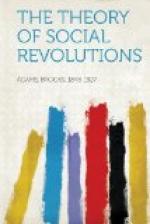Danton died on the 5th April, 1794; about three months later Jourdan won the Fleurus campaign. Straightway Thermidor followed, and the Tribunal worked as well for the party of Thermidor as it had for the Jacobins. Carrier, who had wallowed in blood at Nantes, as the ideal Jacobin, walked behind the cart which carried Robespierre to the scaffold, shouting, “Down with the tyrant;” but that did not save him. In vain he protested to the Convention that, were he guilty, the whole Convention was guilty, “down to the President’s bell.” By a vote of 498 out of 500, Carrier was sent before the Tribunal which, even though reorganized, condemned him. Therezia Cabarrus gaily presided at the closing of the Jacobin Club, Tallien moved over to the benches on the right, and therefore the court was ruthless to Fouquier. On the 11 Thermidor, seventy members, officers, or partisans of the Commune of Paris, were sent to the guillotine in only two batches. On the next day twelve more followed, four of whom were jurymen. Fouquier’s turn came later. It may also be worth while for Americans to observe that a political court is quite as effective against property as against life. The Duke of Orleans is only the most celebrated example of a host of Frenchmen who perished, not because of revenge, fear, or jealousy, but because the party in power wanted their property. The famous Law touching Suspected Persons (loi des suspects) was passed on September 17, 1793. On October 10, 1793, that is three weeks afterward, Saint-Just moved that additional powers should be granted, by the Convention, to the Committee of Public Safety, defining, by way of justification for his motion, those who fell within the purview of this law. Among these, first of all, came “the rich,” who by that fact alone were to be considered, prima facie, enemies to their country.
As I stated at the beginning of this chapter, history never can repeat itself; therefore, whatever else may happen in the United States, we certainly shall have no Revolutionary Tribunal like the French Tribunal of 1793, but the mechanical principle of the political court always remains the same; it is an administrative board the control of which is useful, or may be even essential, to the success of a dominant faction, and the instinctive comprehension which the American people have of this truth is demonstrated by the determination with which they have, for many years, sought to impose the will of the majority upon the judiciary. Other means failing to meet their expectations, they have now hit on the recall, which is as revolutionary in essence as were the methods used during the Terror. Courts, from the Supreme Court downward, if purged by recall, or a process tantamount to recall, would, under proper stress, work as surely for a required purpose as did the tribunal supervised by Fouquier-Tinville.




